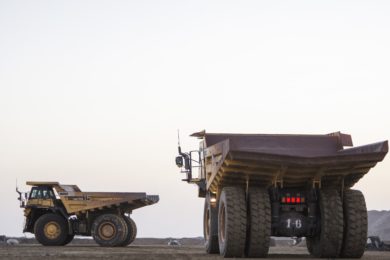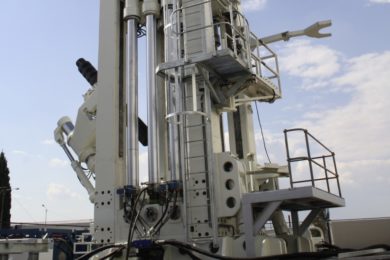Canada-headquartered Kinross Gold Corporation recently announced details of its Climate Change Strategy and greenhouse gas (GHG) reduction action plan, which includes the company’s commitment to working towards the goals of the 2015 Paris Agreement. To tackle Scope 1 emissions, it includes entering into an agreement with Komatsu to take an active role in the development of a Zero Emission Haulage Solution, which will target the development of zero-emission haul trucks.
Kinross is a major global gold mining company (production of 2.07 Moz in 2021 expected to rise to 2.65 Moz in 2022) with mines and projects in the United States (Fort Knox, Alaska; Bald Mountain & Round Mountain, Nevada), Brazil (Paracatu), Russia (Kupol), Mauritania (Tasiast), Chile (La Coipa) and Ghana (Chirano).
The Climate Change Strategy is aligned with Kinross’ previously-announced goal of being a net-zero GHG emissions company by 2050, and has set a target to achieve a 30% reduction in intensity per ounce produced of scope 1 and scope 2 emissions by 2030. As the company advances its strategy, it says it will also work with its suppliers on addressing Scope 3 emissions.
Kinross says it recognises the global importance of climate change and the company’s responsibility to contribute positively to mitigating its impacts, as well as its significance as a strategic matter to the business. “The Climate Change Strategy is in line with Kinross’ values and commitment to sustainable mining, and builds on its strong record in this area. These commitments are also consistent with the company’s sustainability policies, and its commitment to ESG, ethical conduct and human rights, and align with the Just Transition framework to ensure that employees’ and communities’ rights and livelihoods are protected as the company implements its strategy.”
The strategy is structured into five main pillars. First, incorporating energy efficient and renewable energy projects into operations. Over the past decade, the company has made significant progress in improving the energy efficiencies of its operations, including advancing site-specific projects which have saved approximately 30,000 t in GHG emissions annually. The company is budgeting $50 million in 2022 for ESG-related capital expenditures, which includes developing a 34 MW solar power plant at Tasiast in Mauritania, and studying building a power line to connect the Udinsk project into the regional grid in Russia, as opposed to self-generating electricity with diesel. Kinross also signed a power purchase agreement for 100% renewable power at the La Coipa project in Chile, and incorporated electric shovels, solar power for the camp, and an ore conveyor system to reduce the use of haul trucks in the Lobo-Marte project plan.
Secondly, partnering with equipment manufacturers and energy suppliers to reduce GHG emissions and energy use. “As 90% of the company’s current Scope 1 and Scope 2 emissions are from power generation and mine fleets, a significant part of its GHG reduction strategy will include strategic partnerships with equipment manufacturers and energy suppliers.” Current initiatives include the mentioned agreement with Komatsu on Zero Emission Haulage. It also includes supporting research for a new crushing and grinding system that could radically reduce energy use in comminution circuits. Kinross says it will also continue to work with local energy suppliers on reducing emissions in power generation. In 2020, approximately 36% of electricity used by Kinross operations was sourced from renewable sources from local or country grids.
Third, embedding climate change considerations into strategic business decisions. “Kinross will maintain its focus on climate change as a key consideration in its overall business strategy, project development plans, mine life planning and financial analysis. For example, the company has acquired two hydroelectric power plants in Brazil with 155 MW rated capacity in 2018 to increase renewable energy use at Paracatu; incorporated ESG considerations into its M&A strategy, including pursuing acquisitions in low-carbon jurisdictions, such as the recent agreement to acquire Great Bear Resources and its Dixie project in Red Lake, Ontario; and included the use of a notional market price for carbon in the company’s financial analysis and decision-making processes.”
Fourth, maintaining robust governance and transparent reporting. Kinross says sustainability governance and reporting will continue to be integral to its strategy, including continuing its long history of disclosure on energy use, greenhouse gas emissions and climate-related risks, which date back to the company’s first submission to the CDP in 2005; reporting in alignment with the recommendations of the Task Force on Climate-related Financial Disclosures (TCFD), which includes the publication of its first Climate Report in 2021; and establishing an ESG Executive Committee that reports to the Senior Leadership Team, and to Kinross’ Board on a quarterly basis, to help further improve sustainability governance.
Finally, enhancing the business’ resiliency to climate change to mitigate risks. “Kinross prioritises risk management and protecting its operations and overall business success through a dynamic risk management system that includes commissioning a third-party assessment on climate risks across its global portfolio in 2020 and incorporating risks into multi-disciplinary risk management systems at all Kinross sites and enterprise risk management system.”
“Operating responsibly in a manner that is protective of the environment is fundamental to Kinross’ values and business strategy. As part of our commitment to prioritising sustainability, we acknowledge the global importance of taking action on climate change and creating a long-term plan to mitigate our impacts,” said J. Paul Rollinson, Kinross President and CEO. “Our Climate Change Strategy and goals are not only essential to safeguarding the environment, they are also vital to the long-term success of our business. We will continue building on our position as one of the lowest GHG emitters among our peers to make a tangible contribution to help mitigate climate change.”
In line with Kinross’ commitment to capital discipline, budgetary allocations for projects related to the Climate Change Strategy “will be based on an evaluation of their economic viability, in addition to their potential to contribute to the company’s sustainability goals.”










